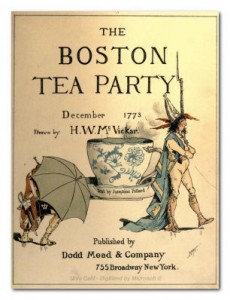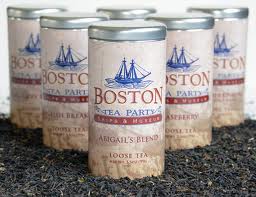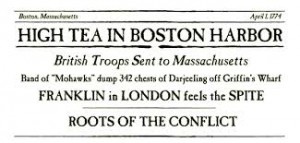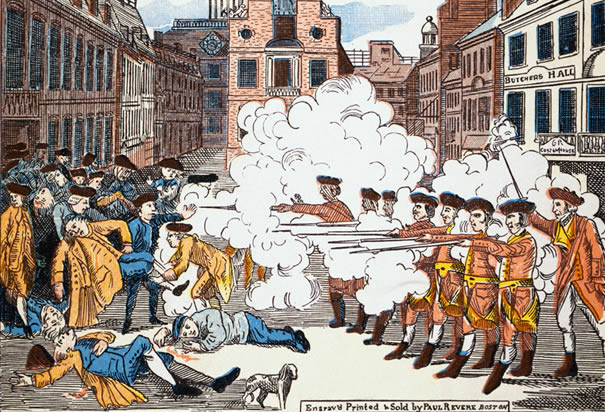
Boston Massacre, a print by Paul Revere
The Boston Massacre (1770) pitted British soldiers against local workers and resulted in the death of five men. The event galvanized many towards the cause of independence from the British. (Photo Credit: Bettmann/CORBIS)
The Boston Tea Party of December 16, 1773, took place when a group of Massachusetts Patriots, protesting the monopoly on American tea importation recently granted by Parliament to the East India Company, seized 342 chests of tea in a midnight raid on three tea ships and threw them into the harbor.
This action, part of a wave of resistance throughout the colonies, had its origin in Parliament’s effort to rescue the financially weakened East India Company so as to continue benefiting from the company’s valuable position in India. The Tea Act (May 10, 1773) adjusted import duties in such a way that the company could undersell even smugglers in the colonies. The company selected consignees in Boston, New York, Charleston, and Philadelphia, and 500,000 pounds of tea were shipped across the Atlantic in September.
Under pressure from Patriot groups, the consignees in Charleston, New York, and Philadelphia refused to accept the tea shipments, but in Boston, the chosen merchants (including two of Governor Thomas Hutchinson’s sons as well as his nephew) refused to concede. The first tea ship,Dartmouth, reached Boston November 27, and two more arrived shortly thereafter. Meanwhile, several mass meetings were held to demand that the tea be sent back to England with the duty unpaid. Tension mounted as Patriot groups led by Samuel Adams tried to persuade the consignees and then the governor to accept this approach. On December 16, a large meeting at the Old South Church was told of Hutchinson’s final refusal. About midnight, watched by a large crowd, Adams and a small group of Sons of Liberty disguised as Mohawk Indians boarded the ships and jettisoned the tea. To Parliament, the Boston Tea Party confirmed Massachusetts’s role as the core of resistance to legitimate British rule. The Coercive Acts of 1774 were intended to punish the colony in general and Boston in particular, both for the Tea Party and for the pattern of resistance it exemplified.
The Boston Tea Party was one of a long series of conflicts between the American colonies and the English government after the British victory in the French and Indian War (1754–63). The French and Indian War was the last and most expensive of almost a century of colonial wars between France and England. Since a lot of this money was spent to protect the American colonists from French Canadians and their Native American allies, the British government felt the Americans should help pay for the war. They also wanted the colonists to pay some of the future costs of stationing soldiers at forts scattered over the new Western frontier. The Americans, for their part, saw little sense in sending money to England to pay for troops that were needed much closer to home.
During the 1760s Parliament passed a series of acts designed to reduce the British national debt and to finance the costs of keeping regular soldiers on the American frontier. The most notorious of these was the Stamp Act (1765), which placed a tax on almost every public piece of paper in the colonies, including newspapers, pamphlets, diplomas, licenses, packs of cards, almanacs, and dice. The colonists fiercely resisted these taxes, organizing public protests and intimidating tax collectors. The Stamp Act resistance was the most widespread and best organized inter–colonial protest before the tea crisis of the 1770s. In the face of such widespread opposition the British Parliament backed down. It repealed the Stamp Act and its companion taxes in 1766.
Did You Know?
It took nearly three hours for more than 100 colonists to empty the tea into Boston Harbor. The chests held more than 90,000 lbs. (45 tons) of tea, which would cost nearly $1,000,000 dollars today.
The Reader’s Companion to American History. Eric Foner and John A. Garraty, Editors. Copyright © 1991 by Houghton Mifflin Harcourt Publishing Company.
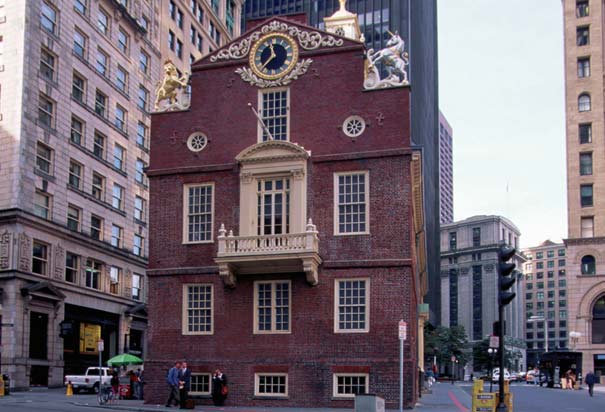
Site of the Boston Massacre
A circle of cobblestones marks the site of the Boston massacre. In the background stands the Old State House, built-in 1713 (photographed in 1995). (Photo Credit: Kevin Fleming/CORBIS)
There were actually two Boston Tea Parties, to learn more about this and see what ethnic groups fought for the colonies check out this video — http://www.history.com/topics/boston-tea-party/videos#bet-you-didnt-know-revolutionary-war


